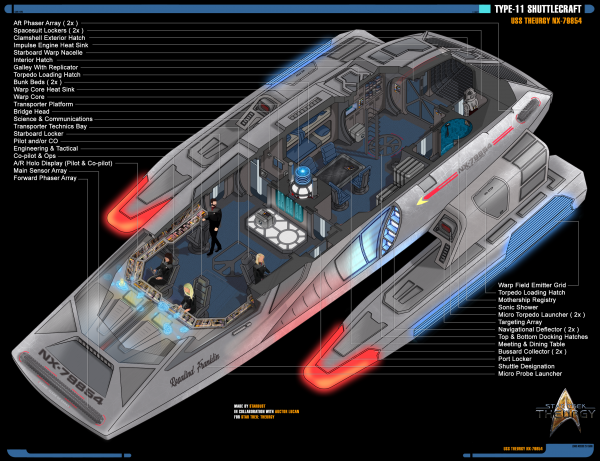Type-11 Shuttlecraft
From Star Trek: Theurgy Wiki
The Type-11 shuttlecraft was a large auxiliary craft issued to certain Starfleet ships and starbases throughout the 2370s. By 2381, the Type-11 shuttlecraft had become ubiquitous throughout the Federation as one of the largest and most capable auxiliary craft in any starship's inventory, with several Type-11s being delivered to the USS Theurgy.
Production History
In the late 2360s, the introduction of the new Galaxy-class starships brought with them new lessons for Starfleet. In particular, classic shuttlecraft designs were deemed to be insufficient for Starfleet's expanding needs as auxiliary craft were relied on more and more by starship crews. Creative starship crews began to use the plentiful shuttlecraft aboard the new Galaxy-class for missions beyond their design parameters, supplementing exploration of large areas and even for short-term science missions, forcing Starfleet to adapt. The Type-9 shuttlecraft, while promising, was far too small to accommodate crew comfort for multi-day missions, and increasing loss rates were beginning to alarm Starfleet Command. The Danube-class runabout, while sufficiently capable, was far too large and expensive to be deployed to the fleet in general.
As a result, the Type-11 project was launched in 2369 in the hopes of the type being ready for the new Sovereign-class starships then under construction. The mandate was simple enough: build an intermediate design between the Type-9 shuttle and the Danube-class runabout, with modularity for ease of maintenance. The design needed sleeping accommodation for multi-day missions and the same warp performance as a runabout, although Starfleet compromised on flight endurance and tactical capability. At the same time, the Type-11 was mandated to be of flatter, more streamlined design, than the Danube-class inspirations, to accommodate most starship shuttle bays more easily.
Using technology developed for the Sovereign-class starships, the first line of Type-11 shuttles were built in 2372, first deployed to the USS Sovereign, USS Enterprise and USS Poseidon. The shuttles proved an immediate success, leading to the widespread adoption of the craft throughout the Federation, finding a place on most large starships. Serving effectively during the Dominion War and beyond, the Type-11 would become the standard large shuttlecraft for Starfleet for many years to come.
Propulsion Systems
The micro-warp core in the type-11, despite being considerably smaller and less powerful than the warp core of the Danube-class runabout, provided similar performance. At a cruising speed of warp 4, the type-11 could cover considerable distance within only a few days, facilitating precisely the sort of missions envisaged for the type-11. Moreover, the warp core was modular and easily accessed from the transporter pad, to ensure ease of maintenance for a starship crew with limited resources and manpower. Despite some safety concerns as a result of the design, with the center-placed warp core proving more vulnerable to external damage, the economic and ergonomic trade-offs were judged to be worth the increased risk.
As an unexpected benefit of the warp core design, the type-11’s warp drive could be modified and enhanced with relative ease by an inventive individual. Given the increased risk of a warp core breach as a result, however, the Corps of Engineers officially declared that such modifications were “not advised”.
At sunlight, the type-11 performed much as expected for its size, being far clumsier than the smaller type-9 but far more maneuverable than actual starships or even runabouts.
Tactical Systems
While reasonably well armed for a shuttle, the type-11 was not designed for any sort of serious combat. Equipped with three type-IV phaser arrays to ensure omnidirectional fire, the shuttle’s weapons were intended more as weapons of opportunity than practicality. The true teeth of the craft came from its micro photon torpedoes, providing a measure of offensive firepower against more heavily defended targets. The micro-torpedo launchers also fired configurable micro-probes, permitting increased versatility.
Due to its size, design and innovative warp core, the type-11 had impressive shield systems, nearly three times more resilient than the smaller type-9.
Crew Support Systems
In keeping with its design mandate, the type-11 incorporated a separate aft compartment that included a small galley, a replicator, two bunks, a waste disposal port, a sonic shower and numerous storage closets.


